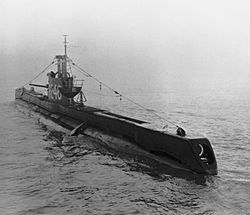HMS Statesman (P246)
| HMS Statesman (P246) Sultans |
|
|---|---|

|
|
| General data | |
| Ship type : | Submarine |
| Ship class : | Seraph class ( S class ) |
| Navies : |
|
| Builder : | Cammell Laird ( Birkenhead ) |
| Keel laying : | November 2, 1942 |
| Launch : | September 14, 1943 |
| Commissioning: |
|
| Whereabouts: | Sold for scrapping on January 3, 1961. |
| Technical specifications
(see Seraph class ) |
|
HMS Statesman (P246) was a submarine of the British Royal Navy . The Statesman is considered to be the submarine that carried out the last successful torpedo attack of World War II .
The boat was used by the French Navy between 1952 and 1959 under the name Sultans .
history
The Statesman ( English: statesman ) was a boat of the third batch of the successful S-Class ; this lot is also known as the Seraph class . The boat was launched on November 2, 1942 at Cammell Laird in Birkenhead , northwest England, was launched on September 14, 1943 and was commissioned by the Royal Navy on December 13, 1943.
The Royal Navy used the boat in the Pacific War .
On August 22, 1944, the Statesman torpedoed and sank the Japanese military transporter Sugi Maru No. 5 (the Norwegian merchant ship Gran , formerly sailing under the Panamanian flag ; 1983 BRT ) off Port Blair ( Andaman Islands ) at 11 ° 40 ′ N , 92 ° 45 ′ E . On October 6, she sank two Japanese sailing ships with the deck gun off the Mergui Islands ( Burma ) . On December 29th, another Japanese sailing ship was sunk northeast of Sumatra ( Dutch East Indies ). On January 1, 1945, four other smaller Japanese units followed in the same sea area and on February 6, two sailing ships in the Malakka Strait . On February 17, the recessed Statesman in the Malay road at 4 ° 26 ' N , 98 ° 16' O Japanese trawler Matsujima Maru no. 3 and the three Japanese coasters Nippon Maru no. 19 , Nanyo Maru no. 17 and Nippon Maru No. 14 with the deck gun. Between February 20 and May 15, the Statesman destroyed 30 smaller Japanese transport units in Malakka Street (mostly: junks and landing craft ). The often unarmed and unprotected units were sunk mainly with deck guns, but also with explosive charges by boarding teams.
On May 9, 1945, the Japanese heavy cruiser Haguro and the destroyer Kamikaze left Singapore to supply troops in the Andaman Islands. The Statesman and the Subtle discovered the association on May 10th . The Royal Navy then immediately set up a task force in Trincomalee ( Ceylon ) consisting of two battleships , a heavy cruiser, two light cruisers , four escort aircraft carriers and eight destroyers. The Haguro was sunk on May 16 by the vastly superior forces. The kamikaze was able to pull away.
The Statesman sank a Japanese sailing ship north of Sumatra on June 26, 1945 and five sailing ships in Malakka Strait on August 14. On August 18, 1945, three days after the capitulation of Japan , the Statesman torpedoed and sank the floating wreck of a Japanese coaster in the Malakka Strait. This attack is considered to be the last successful torpedo attack by a submarine in World War II. Since then, there have only been two other successful submarine torpedo attacks in real war operations: In the Bangladesh war, the Pakistani submarine PNS Hangor sank the Indian frigate INS Khukri on December 9, 1971 , and in the Falklands War the British nuclear submarine sank Boat HMS Conqueror on May 2, 1982 the Argentine cruiser General Belgrano .
After the war, the boat was handed over to the French Navy in 1952 and renamed Sultans . On November 5, 1959, the French returned the boat. It was sold for scrapping on January 3, 1961.
See also
- Sultans (other French ships named Sultans )
- List of French submarine classes
Web links
literature
- Erminio Bagnasco: Submarines in World War II , Motorbuchverlag, Stuttgart, 5th edition 1996, ISBN 3-613-01252-9
- Robert Hutchinson: KAMPF UNDER WASSER - Submarines from 1776 to today , Motorbuchverlag, Stuttgart, 1st edition 2006, ISBN 3-613-02585-X
- Anthony Preston: The history of the submarines , Karl Müller Verlag, Erlangen, German edition 1998, ISBN 3-86070-697-7
Footnotes
- ↑ HMS is the abbreviation for His / Her Majesty's Ship and the name prefix of British ships. HMS means His / Her Majesty's Ship .
- ↑ See http://www.combinedfleet.com/ ( engl. )
- ↑ See http://www.combinedfleet.com/ (engl.)
- ↑ As of September 1, 2007